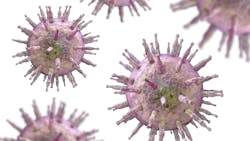Why viruses should be part of the health history
I can hear the lunchroom chatter now. “Did you hear? Olivia is sick; she has that ‘kissing disease.’” You remember, the one that causes a sore throat, fever, and extreme fatigue. Mononucleosis (mono) is probably the most well-known saliva-associated communicable disease.1 It’s not to be confused with the spread of cold sores (HSV-1) and hand, foot, and mouth disease (Coxsackie virus) that is transmitted through open sores.
Mono is transmitted through saliva and caused by the Epstein-Barr virus (EBV), which is part of the herpes family—the same kinfolk that bring us chicken pox, cold sores, and shingles. EBV is extremely common, and an estimated 90% of adults worldwide carry the virus.2 It usually doesn’t cause symptoms in children, but between 30% and 50% of adolescents and adults who have the virus will develop infectious mono.1
EBV (or HHV-4) is a widely disseminated herpesvirus previously called human gammaherpesvirus 4, a double-stranded DNA virus. Diseases associated with this subfamily of viruses include not only HHV-4 but also HHV-8, Kaposi’s sarcoma. EBV infects human B lymphocytes and epithelial cells and is responsible for infectious mononucleosis. It’s one of nine herpesvirus types that primarily infect humans and can increase the risk for certain cancers and immune system disorders.3-7
After exposure, the virus lies dormant in the cells, not causing symptoms, but it can be reactivated by stress or a weakened immune system. If one gets mono a second time, the symptoms will be milder or even nonexistent. Chronic active Epstein-Barr virus (CAEBV) is rare and can present similarly to mono, but it can also manifest with other conditions such as anemia, pneumonia, or viral hepatitis.
You may also be interested in ... Long COVID and its systemic health impacts
In the US, patients have virus involvement in their B or T cells with the only effective treatment being a stem cell transplant. The EBV test is a serum test that looks at the production of antibodies specifically for that virus, and it can determine whether you have a current or past infection. About 70% of people tested will have antibodies indicative of past infections.8
Link to periodontal disease
EBV is associated with several types of periodontal disease and may be a cause of periodontitis.9,10 Active herpesvirus infections correlate with periodontal disease activity and upregulate several pro-inflammatory cytokines such as interleukin-1 beta, tumor necrosis factor-alpha, and gene expression of monocytes and macrophages.11 The pro-inflammatory cascade of the virus can impede antibacterial host defense, fuel osteoclastic activation, and upregulate matrix metalloproteinase (MMP).12-14
MMPs may sound familiar because drugs such as doxycycline or minocycline have been shown to inhibit MMP activity in periodontal patients. Under normal conditions, the activity of MMPs is precisely regulated, but when there is a loss of activity control, it can result in diseases such as arthritis, cancer, atherosclerosis, aneurysms, nephritis, tissue ulcers, or fibrosis.15 EBV DNA is more frequently detected in deep periodontal pockets in patients with periodontitis than in healthy pockets.16 Patients with deep pockets and bleeding versus those without deep pockets and bleeding had higher oral EBV DNA, showing a significant relationship between periodontitis and EBV.17
Autoimmune relationships
Autoimmune diseases affect more than 20 million Americans.18 EBV correlates with a host of autoimmune conditions such as lupus, fibromyalgia, Hashimoto’s thyroiditis, Graves’ disease, and multiple sclerosis (MS). In fact, 100% of people with MS have EBV, and 99% of children with lupus have EBV. There are a few theories as to why EBV triggers autoimmune diseases:
- Molecular mimicry: The virus accidentally attacks tissues because it mistakes them for structurally similar infections.19
- Bystander activation: The virus invades the organs, and the immune system sends immune cells to kill the infection, but it ends up injuring tissues in the process. This creates an inflammation loop.20
- Cryptic antigens: The infection hijacks the cell’s DNA to hide from the immune system. The smart immune system can still identify the virus, but it ends up attacking cells along with the virus.21
Research in 2018 found a connection among EBV, our genes, environmental factors, and autoimmunity. EBV can turn on certain genes, the ones that can cause autoimmune conditions.22 EBV infections can affect the nervous system with diseases such as Guillain-Barré, encephalitis, and optic neuritis. The virus can produce high numbers of white blood cells (lymphocytes), weakening the immune system and making it harder to fight infection. It can also cause pneumonia, pancreatitis, and myocarditis.
Dental complications
For dental providers, some concerning complications of an EBV infection could be peritonsillar abscesses, acute bacterial sinusitis, mastoiditis (a bacterial infection of the mastoid bone in the skull), and sialadenitis (swollen salivary glands). Since the 1980s, oral hairy leukoplakia has been associated with EBV, but it shouldn’t be confused with oral candidiasis as they look similar in appearance. There are usually no treatment recommendations for hairy leukoplakia.
To elevate our oral-systemic game, should we include a virus health history on our patient medical history questionnaires? Instead of saying, “Do you get cold sores?” ask, “Have you had EBV, chicken pox, shingles, or any other virus?” The relationship between viruses and periodontal disease is complex, but if we are on the lookout for indicators of susceptibility, it will put us a little ahead of the curve. In the coming year in this column, we’ll explore more about viruses.
Editor’s note: This article appeared in the June 2023 print edition of RDH magazine. Dental hygienists in North America are eligible for a complimentary print subscription. Sign up here.
References
- Whitley RJ. Herpesviruses. In: Baron S, ed. Medical Microbiology. 4th ed. University of Texas Medical Branch at Galveston; 1996:chap 68.
- De Paschale M, Clerici P. Serological diagnosis of Epstein-Barr virus infection: problems and solutions. World J Virol. 2012;1(1):31-43. doi:10.5501/wjv.v1.i1.31
- Saha A, Robertson ES. Epstein-Barr virus-associated B-cell lymphomas: pathogenesis and clinical outcomes. Clin Cancer Res. 2011;17(10):3056-3063. doi:10.1158/1078-0432.CCR-10-2578
- Piccaluga PP, Gazzola A, Agostinelli C, Bacci F, Sabattini E, Pileri SA. Pathobiology of Epstein-Barr virus-driven peripheral T-cell lymphomas. Semin Diagn Pathol. 2011; 28(3):234-244. doi:10.1053/j.semdp.2011.02.007
- Incaprera M, Rindi L, Bazzichi A, Garzelli C. Potential role of the Epstein-Barr virus in systemic lupus erythematosus autoimmunity. Clin Exp Rheumatol. 1998;16(3):289-294.
- Youinou P, Buisson M, Berthelot JM, et al. Anti-Epstein-Barr virus-nuclear antigen-1, -2A and -2B antibodies in rheumatoid arthritis patients and their relatives. Autoimmunity. 1992;13(3):225-231. doi:10.3109/08916939209004828
- Csuka D, Simon D, Hóbor R, et al. Serum concentration of immunoglobulin G-type antibodies against the whole Epstein-Barr nuclear antigen 1 and its aa35-58 or aa398-404 fragments in the sera of patients with systemic lupus erythematosus and multiple sclerosis. Clin Exp Immunol. 2013;171(3):255-262. doi:10.1111/cei.12022
- Hess RD. Routine Epstein-Barr virus diagnostics from the laboratory perspective: still challenging after 35 years. J Clin Microbiol. 2004;42(8):3381-3387. doi:10.1128/JCM.42.8.3381-3387.2004
- Slots J. Herpesviruses in periodontal diseases. Periodontol 2000. 2005;38:33-62. doi:10.1111/j.1600-0757.2005.00109.x
- Slots J. Human viruses in periodontitis. Periodontol 2000. 2010;53:89-110. doi:10.1111/j.1600-0757.2009.00325.x
- Contreras A, Slots J. Herpesviruses in human periodontal disease. J Periodontal Res. 2000;35(1):3-16. doi:10.1034/j.1600-0765.2000.035001003.x
- Mogensen TH, Paludan SR. Molecular pathways in virus-induced cytokine production. Microbiol Mol Biol Rev. 2001;65(1):131-150. doi:10.1128/MMBR.65.1.131-150.2001
- Page RC, Offenbacher S, Schroeder HE, Seymour GJ, Kornman KS. Advances in the pathogenesis of periodontitis: summary of developments, clinical implications and future directions. Periodontol 2000. 1997;14:216-248. doi:10.1111/j.1600-0757.1997.tb00199.x
- Slots J. Herpesviral-bacterial interactions in periodontal diseases. Periodontol 2000. 2010;52(1):117-140. doi:10.1111/j.1600-0757.2009.00308.x
- Woessner JF Jr. Role of matrix proteases in processing enamel proteins. Connect Tissue Res. 1998;39(1-3):69-149. doi:10.3109/03008209809023913
- Dawson DR, Wang C, Danaher RJ, et al. Real-time polymerase chain reaction to determine the prevalence and copy number of Epstein-Barr virus and cytomegalovirus DNA in subgingival plaque at individual healthy and periodontal disease sites. J Periodontol. 2009;80(7):1133-1140. doi:10.1902/jop.2009.080644
- Su CY, Shigeishi H, Murodumi H, SugiyaMa M, Ohta K, Takemoto T. Association of oral Epstein-Barr virus with periodontal health in Japanese adults. Exp Ther Med. 2021;22(1):767. doi:10.3892/etm.2021.10199
- Autoimmune diseases. National Institute of Environmental Health Sciences. Reviewed May 31, 2022. Accessed February 17, 2023. https://www.niehs.nih.gov/health/topics/conditions/autoimmune/index.cfm
- Cusick MF, Libbey JE, Fujinami RS. Molecular mimicry as a mechanism of autoimmune disease. Clin Rev Allergy Immunol. 2012;42(1):102-111. doi:10.1007/s12016-011-8294-7
- Fujinami RS, von Herrath MG, Christen U, Whitton JL. Molecular mimicry, bystander activation, or viral persistence: infections and autoimmune disease. Clin Microbiol Rev. 2006;19(1):80-94. doi:10.1128/CMR.19.1.80-94.2006
- Lanzavecchia A. How can cryptic epitopes trigger autoimmunity? J Exp Med. 1995;181(6):1945-1948. doi:10.1084/jem.181.6.1945
- Harley JB, Chen X, Pujato M, et al. Transcription factors operate across disease loci, with EBNA2 implicated in autoimmunity. Nat Genet. 2018;50(5):699-707. doi:10.1038/s41588-018-0102-3
About the Author

Anne O. Rice, BS, RDH, CDP, FAAOSH
Anne O. Rice, BS, RDH, CDP, FAAOSH, founded Oral Systemic Seminars after over 35 years of clinical practice and is passionate about educating the community on modifiable risk factors for dementia and their relationship to dentistry. She is a certified dementia practitioner, a longevity specialist, a fellow with AAOSH, and has consulted for Weill Cornell Alzheimer’s Prevention Clinic, FAU, and Atria Institute. Reach out to Anne at anneorice.com.
